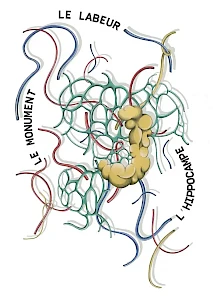Le monument, le labeur et l’hippocampe
| Date: | 17. Sep – 15. Nov 2020 |
| Venues: | La Kunsthalle, Mulhouse, France |
| Works: | |
| Projects: | |
| Catalogues: |
The hippocampus is a small brain organ that looks very much like a seahorse. It is located in the temporal lobe and it is involved in long-term memory, in other words our memories from the moment we are able to remember.
It plays an important role in the storage of explicit knowledge, that which can be articulated through language. It is also the seat of what is known as episodic memory, which allows us to record factual and contextual information, and to travel mentally through time and space.
We owe our ability to remember past events, and to project ourselves into an imaginary future, to our hippocampus. It records events, details, places, sounds and emotional states which can reappear as triggered memories.
What if we assumed that objects, not only humans, had hippocampi? Not only would this memory, buried in bodies and stones, play a major role in our projections, it would also confirm the importance of preserving oral and material testimonies. Recognizing the power of memory to shape the future also means choosing transmission over reconstruction.
One could argue that the not so distant history of the 20th century is called contemporary because it is still present in many people’s memories. The artists in the exhibition have listened to, transcribed or filmed memories that are still vivid; they have also extended them. They have looked for traces which have resisted the passing of time in different ways. Some memories have become greater, others have become darker. All of them are parts of unfinished stories.
The Monument, the Toil and the Hippocampus is an exhibition based on the case of Mulhouse. The recent history of the city provides a model but it is not the only point of reference. What the city reveals from its past, and how it deals with it, is valid for other cities and other regions. It exemplifies an industrial history made up of buildings, workers and a conception of progress which remained dominant for a long time but whose promises were not necessarily fulfilled.
The events and habits of a period gradually become facts and sorted files. They are released and consulted to write a history to which the artists in the exhibition wished to contribute. They have chosen not to limit themselves to the archived versions of the memories, but to reactivate them, with no compromise or prejudice. They have revived words, gestures and places which can bridge the gap between then and now.
Artists: Véronique Arnold (FR), Hélène Bleys (FR), Irina Botea (RO) et Jon Dean (UK), Tanja Boukal (AT), Igor Grubic (HR), Zhanna Kadyrova (UA)
Curated by Sandrine Wymann
| Download the invitation PDF, 96.8 kB |















